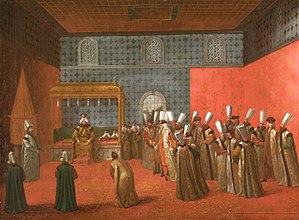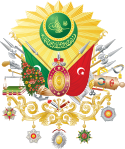Ahmed III
 | |
 Tugra Ahmeda III | |
 | |
| Sułtan Imperium Osmańskiego | |
| Okres | |
|---|---|
| Poprzednik | |
| Następca | |
| Dane biograficzne | |
| Dynastia | |
| Data urodzenia | |
| Data śmierci | |
| Ojciec | |
| Matka | Emetullah Rabia Gulnus |
| Rodzeństwo | |
| Żona | Emine Mihrisah Kadinefendi |
| Żona | Rabia Sermi Kadinefendi |
| Dzieci | Mustafa III, |
Ahmed III (arab. أحمد الثال) (ur. 30 grudnia 1673 – 1 lipca 1736 w Konstantynopolu) – sułtan imperium osmańskiego w latach 1703–1730, czas jego rządów nazywany jest erą tulipanów[1].
Życiorys
Podstawą jego polityki zagranicznej było utrzymywanie dobrych stosunków z Anglią (od 1707 Wielką Brytanią) i Francją, które były zaniepokojone wzrostem potęgi Rosji na wschodzie Europy.


W 1709, w czasie III wojny północnej udzielił schronienia pobitemu w bitwie pod Połtawą królowi Szwecji Karolowi XII. Wspierany przez dyplomację francuską zażądał wycofania wojsk rosyjskich z Rzeczypospolitej, a po odmowie cara Piotra I wypowiedział 20 listopada 1710 wojnę Rosji. Pobita Rosja, zmuszona została podpisać w 1711 traktat prucki, w którym oddawała Osmanom Azow i zobowiązywała się więcej nie mieszać w wewnętrzne sprawy Polski.
W latach 1716–1718 prowadził przegraną wojnę z Austrią i Wenecją, zakończoną utratą Belgradu, północnej Bośni i Serbii. 20 września 1730 został obalony w wyniku przewrotu pałacowego janczarów, którzy wynieśli na tron jego bratanka Mahmuda I. Ahmed III zmarł 6 lat później.
Przypisy
- ↑ Ahmed III, [w:] Encyclopædia Britannica [online] [dostęp 2022-10-03] (ang.).
Media użyte na tej stronie
Ahmet III
Every sultan of the Ottoman Empire had his own monogram, called the tughra, which served as a royal symbol. A coat of arms in the European heraldic sense was created in the late 19th century. Hampton Court requested from the Ottoman Empire a coat of arms to be included in their collection. As the coat of arms had not been previously used in the Ottoman Empire, it was designed after this request, and the final design was adopted by Sultan Abdul Hamid II on 17 April 1882.
Tughra (i.e., seal or signature) of Ahmed III, Sultan of the Ottoman Empire (1703-1730). An explanation of the different elements composing the tughra can be found here.
Autor: Buho07, Licencja: CC BY-SA 3.0
Ottoman Imperial Standard, Late 19th and early 20th Century. Each Sultan had his own Tughra.





